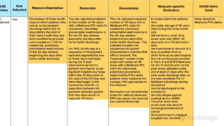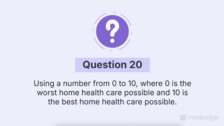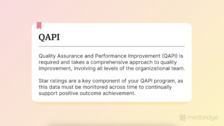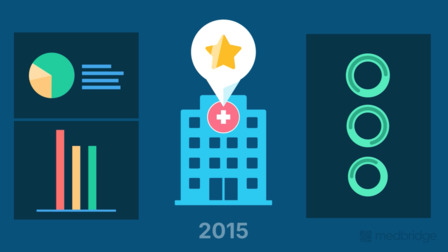Success in Home Health Star Ratings: Key Measures
Presented by Tina Marrelli and Kim Corral
12-Month Subscription
Unlimited access to:
- Thousands of CE Courses
- Patient Education
- Home Exercise Program
- And more
Understanding the detailed components of the CMS Home Health Star Ratings is essential for healthcare providers seeking to improve both patient outcomes and organizational success in home healthcare. This course provides an in-depth exploration of the specific measures that drive the Quality of Patient Care (QoPC) and Patient Survey Star Ratings, building upon the foundational concepts introduced in the first course of the series. Clinicians across disciplines—including nursing, physical therapy, occupational therapy, and speech-language pathology—will gain clarity on the structure, calculation, and data sources that define these ratings. Through real-world scenarios, such as the case of a complex home health patient, learners will explore practical care-planning frameworks that align with quality metrics. This course also highlights how individual clinician practices directly influence agency performance and provides actionable strategies and resources to support continuous quality improvement in the home health setting.
Learning Objectives
- Define terminology found in the CMS Home Health Star Ratings program
- Identify the elements that contribute to Quality of Patient Care measures
- Identify the elements that contribute to the Patient Survey Star Ratings measures
- Recognize the interface between the CMS Home Health Star Ratings measures and quality of patient care
- Recognize where to access CMS quality-related resources
Meet your instructors

Tina Marrelli
Tina Marrelli is the president of Marrelli and Associates, Inc., a publishing and consulting firm working in home care for more than 30 years. Tina is the author of 13 books, including the Handbook of Home Health Standards: Quality, Documentation, and Reimbursement (6th edition, 2018). Other books include A Guide…

Kim Corral
Kim is a registered nurse with a master’s degree in education and more than 30 years of home health experience. She is an experienced leader in home healthcare, having held both clinical and operational positions at regional and national levels for large corporate home health organizations. She brings a passion for providing…
Chapters & learning objectives

1. CMS Home Health Star Rating Program: Terminology and Measure Structure
This chapter defines key terms and outlines the structural framework of the CMS Star Ratings program, including the two rating types: Quality of Patient Care and Patient Survey. It also introduces how to access and interpret data on the Care Compare website, establishing a foundation for understanding each measure’s public-facing consumer and referral source implications.

2. Quality of Patient Care (QoPC) Measures: The Details
This chapter examines the methodology behind process, outcome, and claims-based measures used in calculating the QoPC Star Ratings. Learners will explore how episodes of care are defined, the importance of risk adjustment, and the role of OASIS and hospital data in forming accurate quality assessments.

3. Patient Survey Measures: The Details
Focusing on the HHCAHPS Survey, this chapter breaks down the composite and global measures that make up the Patient Survey Star Ratings. Reflection prompts encourage clinicians to assess how their communication, coordination, and care practices influence the patient experience as well as survey outcomes.

4. Interface With Patient Care, and Application or How-To for Improvement
Through the case scenario of Mrs. Arnez, this chapter illustrates how holistic, individualized care planning directly supports star rating improvements. A structured care framework (H-O-M-E-V-I-S-I-T-S) guides clinicians in aligning their care strategies with measurable outcomes that positively impact both quality and experience ratings.

5. Where Do We Go From Here? Available Resources
This final chapter introduces essential CMS resources and connects star rating efforts to broader Quality Assurance and Performance Improvement (QAPI) initiatives. Emphasizing the clinician’s role in organizational quality, it reinforces the collective responsibility for driving and sustaining optimal home health excellence.
More courses in this series

Success in Home Health Star Ratings: An Overview
Kim Corral and Tina Marrelli

Success in Home Health Star Ratings: Key Measures
Kim Corral and Tina Marrelli

Success in Home Health Star Ratings: Improving Quality of Patient Care
Kim Corral and Tina Marrelli

Success in Home Health Star Ratings: Improving the Patient Survey (HHCAHPS)
Kim Corral and Tina Marrelli

Success in Home Health Star Ratings: Data Strategies
Kim Corral and Tina Marrelli